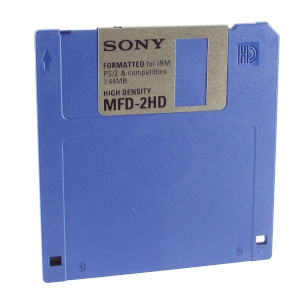
|
This site is running on a 286 PC, booted and served
entirely from a 90mm floppy disk. See current
server stats. All content on this site is provided by the Museum of Obsolete Media, curated by Jason Curtis. My sincerest thanks to Jason for providing me with the worthy challenge of exhibiting his work in the only appropriate way: The Floppy Disk Museum: The Bootable Floppy edition! |


The 3.5-inch HD (High Density) microfloppy was first introduced in 1987, and first used on the IBM PS/2 range, and the Macintosh IIx. It quickly become almost universally used on PC and Macintosh hardware.
High density disks were recognisable by a second hole in the opposite corner to the write-protect notch and a HD logo, but were exactly the same size as the earlier double density microfloppy.
Their formatted capacity was 1.44 MB in both IBM-compatible PCs and Apple Macintosh machines, but this could vary in other systems. For example, in Acorn's RISC OS a floppy could be formatted using ADFS (Advanced Disk Filing System) with a capacity of 1.6 MB, and in AmigaOS a disk could be formatted with a capacity of 1.76 MB. In Japan, some IBM-compatible PCs formatted disks with a capacity of 1.2 MB.
By 1988, the 3.5-inch disk (all types) were outselling the 5.25-inch floppy.
An even higher-capacity Extended Density (ED) microfloppy was introduced in 1991, with a capacity of 2.88 MB, but this variation was not widely used. Throughout the 1990s, various attempts were made to introduce higher capacity 3.5-inch floppy disk replacement, such as the Floptical disk, SuperDisk and HiFD.
Macintosh computers were the first to stop using floppy disks (on the iMac) in 1998, and during the 2000s, PC manufacturers began to remove drives from new PCs.
Dimensions: 94 mm * 90 mm * 3.3 mm
Capacity: 1.44 MB